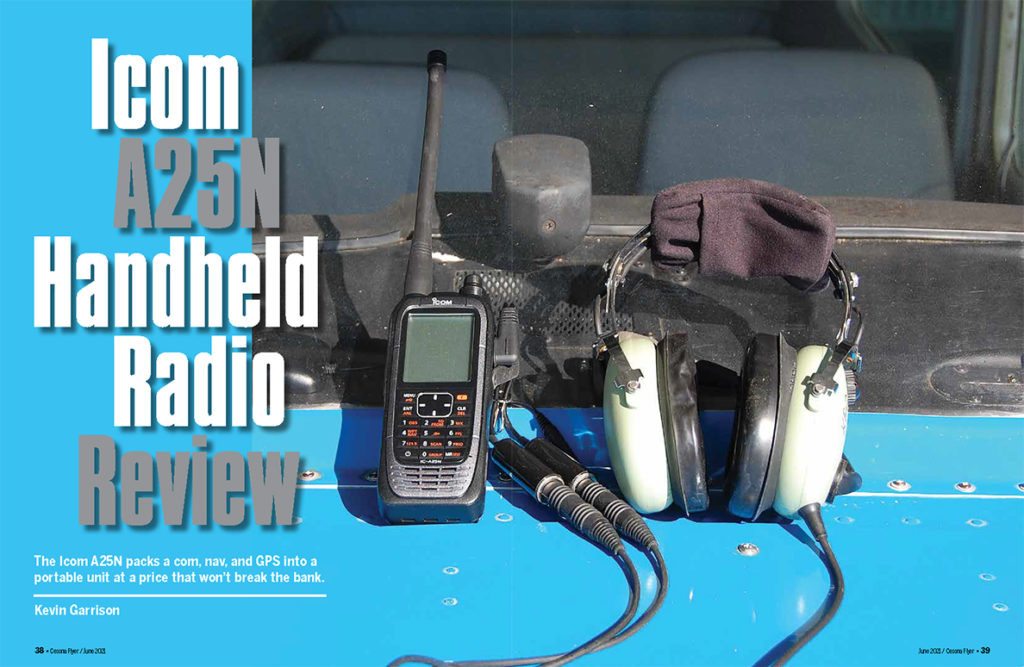Icom A25N Handheld Radio Review – From Cessna Flyer June 2021
by Kevin Macaraeg, Marketing Coordinator

It is easy to take two-way VHF communication for granted until you don’t have it. Lucky for us, there are many handheld radios available for use as a backup way to stay in touch with ATC after a com failure, or to get in touch with help when you find yourself on the ground.
We used to call handhelds “bricks that talk” when I was in the airline world. If you were on the ramp and needed to summon maintenance people, the fastest way was to find a ground worker with a brick that talked.
I recently acquired an Icom A25N as my personal “brick,” and I love it. The unit has an easy-to-use keyboard and a huge screen that makes my aged eyes work a little less hard when I am trying to program and view the radio in the very common turbulence we General Aviation airplane drivers encounter on almost every flight.
This radio sports VOR capability as well as rudimentary GPS. Bluetooth is available for use in linking up with your favorite headset or your electronic devices.
The A25N comes with two battery options. You can go with the included rechargeable battery or the also-included battery pack that uses AAs. I prefer to use the rechargeable one while holding a full battery pack in my flight bag as a backup.
I have so many things in my cockpit that use AAs; I always carry 10 to 20 spare batteries for use in my noise-canceling headphones, etc.
Other publications, the Icom website, and various YouTube videos can fill you in on all the minutiae and terribly interesting facts about this radio…things like how it weighs 13.6 ounces or how many mini gigawatts it needs for time travel. If you are like me, you probably just want a unit that turns on and works when you want it to turn on and work.
I turned it on – it worked!
The best way to try out any piece of aviation equipment is to aviate with it. Using this impeccable logic, I took my Icom out for a test flight a few days ago and ran it through its paces.
The A25N can be used as a primary communications radio if you have an otherwise radio-free aircraft. As a matter of fact, I have a friend with an antique cloth-covered aircraft who uses this radio in just that way. He plugged in the included adapter cables with his headset and was immediately in business.
I have an aircraft with one old com radio that has no VOR function, so I tested out my A25N as a backup/emergency navcom. Note that I included “nav” along with the “com.” Handhelds normally don’t have a navigation function, but the Icom radio has two—VOR and GPS.
I plotted out my test flight to include a simulated com failure in Class C airspace, with some navigation to the local VOR, followed by a set of vectors to return me safely to my home drome.
Before engine start and taxi, I tuned in the weather feature of the radio to get a general idea of the aviation weather in the area. Then, I put in the ATIS frequency and listened to it while sipping my hangar coffee while lounging like royalty in a luxurious cloth lawn chair.
Given that I am flying a very light taildragger, I usually limit myself to a maximum of 15 knots of wind. Had it been too windy that day, I would have saved myself the trouble of schlepping in and out of my aircraft.
Testing, testing, 1,2,3
The weather was great, so I got my clearance for flying out of Class C airspace from my panel-mounted com as usual. Ditto for the taxi clearance, working with the tower, and departure.
Once I was about 10 miles away from the airport, the game was afoot. I switched off my panel-mounted radio to establish a com-out condition. Then, I reached into my flight bag and fished out my A25N.
This took about 15 seconds as I rummaged through various “mandatory” items in my flight kit like water bottles, spare glasses, snack bags, and my ever-present Tabasco sauce and spoon (these are a throwback to my airline days—you never know when or what you are going to eat).
Once out of the bag, the big keyboard made it easy to turn the radio on. I unplugged my headset from my panel, plugged it into the A25N’s adapters, and punched in the departure frequency I had been using. I used the push-to-talk button cable I already had in my cockpit, but could have used the push-to-talk button on the radio if I needed to.
I was back in business. Departure, who I had briefed on what I was about to do so they would not freak out when I momentarily lost contact, said that the A25N sounded just as good as my panel-mounted com.
I exited Class C airspace for a while to test the VOR feature of the A25N. The unit can actively use only one frequency at a time, so if you choose to enter a VOR frequency, you will lose the com frequency.
The VOR feature worked well. Obviously, it was never meant for primary navigation, but I liked the fact that it gave my aircraft a capability it did not have. My plane has three GPSs onboard, but until I got the A25N, I had no VOR.
Once I found and overflew the VOR I was working with, I returned to the communications world by tuning in the ATIS and then getting a clearance back in from Approach Control.
Changing frequencies is easy with the A25N’s big keyboard, and the numbers are easy to see using its big screen. Approach, landing, and taxi-in were done seamlessly, and my new brick that talks had passed its test.
You may ask, “Why didn’t you use the GPS feature of the unit?” I am glad you asked. The A25N does have GPS capability, but it was a little obscure and hard for this aged pilot to use. The unit comes with no internal database, so waypoints have to be entered as latitude/longitude. Icom does offer a free app for your iPhone, and it connects to it through Bluetooth, but I found that the navigation feature already on my iPhone was much easier to use.
The fact that I did not use the GPS was more a reflection of my lack of sophistication than a put-down of Icom’s technology. Other pilots I know say that the capability to make waypoints via Icom’s app is easy for them and gives them the option of making waypoints out of just about anywhere.
I found the A25N to be a solid com radio. The added Bluetooth, VOR, and yet-to-be-used GPS capability will come in handy, and it is a relief for me to have a good backup communication radio in my flight bag.
The Icom A25N sells for around $450 and is available just about everywhere you buy aviation supplies.



